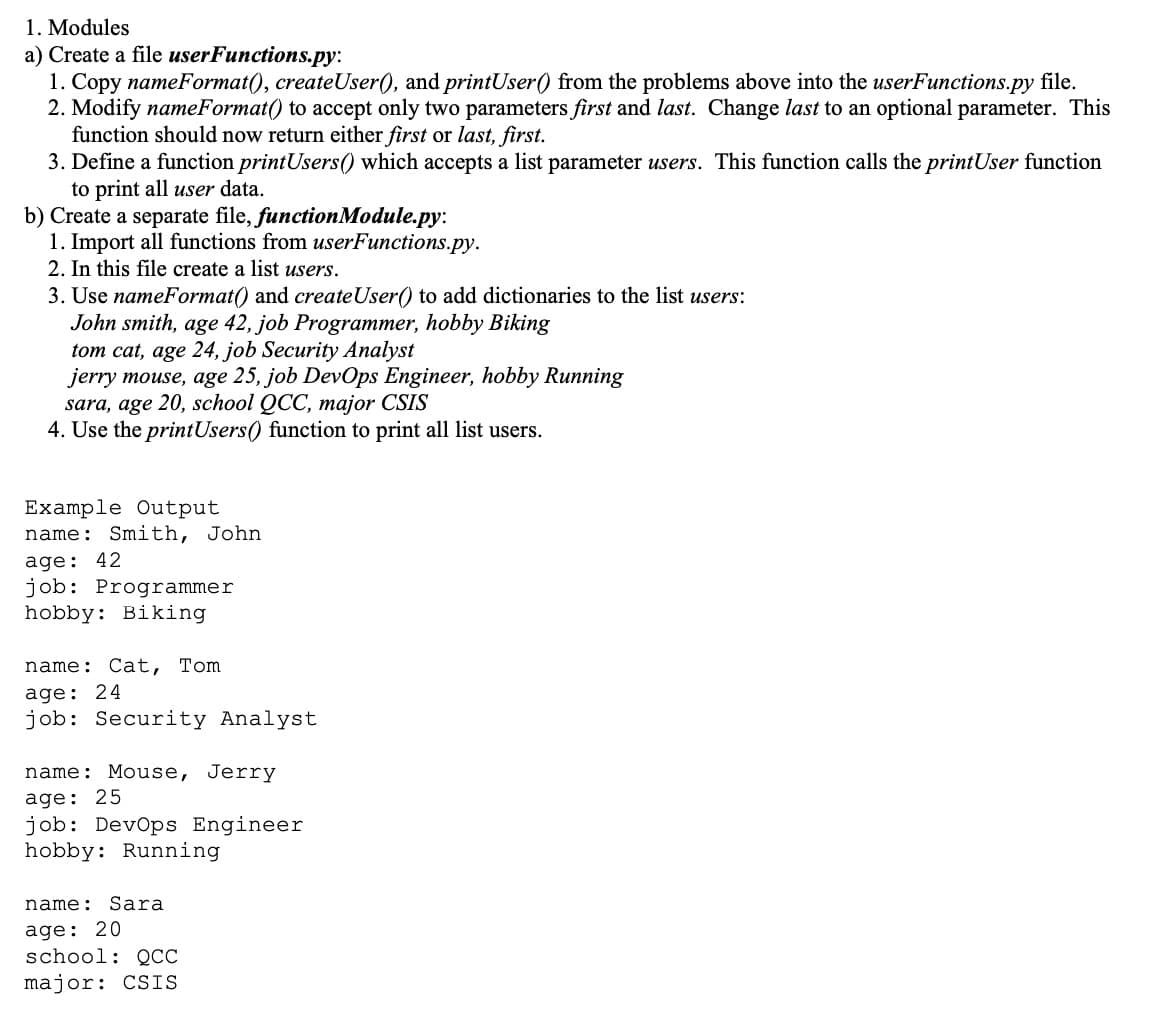1. Modules a) Create a file userFunctions.py: 1. Copy nameFormat(), createUser(), and printUser) from the problems above into the userFunctions.py file. 2. Modify nameFormat() to accept only two parameters first and last. Change last to an optional parameter. This function should now return either first or last, first. 3. Define a function printUsers() which accepts a list parameter users. This function calls the printUser function to print all user data. b) Create a separate file, functionModule.pv:
1. Modules a) Create a file userFunctions.py: 1. Copy nameFormat(), createUser(), and printUser) from the problems above into the userFunctions.py file. 2. Modify nameFormat() to accept only two parameters first and last. Change last to an optional parameter. This function should now return either first or last, first. 3. Define a function printUsers() which accepts a list parameter users. This function calls the printUser function to print all user data. b) Create a separate file, functionModule.pv:
C++ for Engineers and Scientists
4th Edition
ISBN:9781133187844
Author:Bronson, Gary J.
Publisher:Bronson, Gary J.
Chapter8: I/o Streams And Data Files
Section8.3: Random File Access
Problem 6E
Related questions
Question
need help with python.

Transcribed Image Text:1. Modules
a) Create a file userFunctions.py:
1. Copy nameFormat(), createUser(), and printUser() from the problems above into the userFunctions.py file.
2. Modify nameFormat() to accept only two parameters first and last. Change last to an optional parameter. This
function should now return either first or last, first.
3. Define a function printUsers() which accepts a list parameter users. This function calls the printUser function
to print all user data.
b) Create a separate file, functionModule.py:
1. Import all functions from userFunctions.py.
2. In this file create a list users.
3. Use nameFormat() and createUser() to add dictionaries to the list users:
John smith, age 42, job Programmer, hobby Biking
tom cat, age 24, job Security Analyst
jerry mouse, age 25, job DevOps Engineer, hobby Running
sara, age 20, school QCC, major CSIS
4. Use the printUsers() function to print all list users.
Example Output
name: Smith, John
age: 42
job: Programmer
hobby: Biking
name:
Cat, Tom
age: 24
job: Security Analyst
name: Mouse, Jerry
age: 25
job: DevOps Engineer
hobby: Running
name: S ara
age: 20
school: QCC
major: CSIS
Expert Solution
This question has been solved!
Explore an expertly crafted, step-by-step solution for a thorough understanding of key concepts.
This is a popular solution!
Trending now
This is a popular solution!
Step by step
Solved in 2 steps with 2 images

Knowledge Booster
Learn more about
Need a deep-dive on the concept behind this application? Look no further. Learn more about this topic, computer-science and related others by exploring similar questions and additional content below.Recommended textbooks for you

C++ for Engineers and Scientists
Computer Science
ISBN:
9781133187844
Author:
Bronson, Gary J.
Publisher:
Course Technology Ptr

C++ Programming: From Problem Analysis to Program…
Computer Science
ISBN:
9781337102087
Author:
D. S. Malik
Publisher:
Cengage Learning

C++ for Engineers and Scientists
Computer Science
ISBN:
9781133187844
Author:
Bronson, Gary J.
Publisher:
Course Technology Ptr

C++ Programming: From Problem Analysis to Program…
Computer Science
ISBN:
9781337102087
Author:
D. S. Malik
Publisher:
Cengage Learning